60. Volume 11- Number 2 - IP Australia
60. Volume 11- Number 2 - IP Australia
60. Volume 11- Number 2 - IP Australia
You also want an ePaper? Increase the reach of your titles
YUMPU automatically turns print PDFs into web optimized ePapers that Google loves.
PLANT VARIETIES JOURNAL 1998 VOL <strong>11</strong> NO. 2<br />
Special Rural Research Fund, and the Grains Research and<br />
Development Corporation.<br />
Registration information supplied by KV Cooper,<br />
University of Adelaide.<br />
BREAD WHEAT<br />
Triticum aestivum spp. aestivum<br />
‘Chough’<br />
Reg. No. AUS 992<strong>11</strong><br />
Registered on 28/10/97<br />
Originators: L Penrose, K Walsh, R Martin, J Oliver and H<br />
Allen.<br />
NSW Agriculture, Agricultural Research Institute, PMB,<br />
Wagga Wagga, NSW 2650, <strong>Australia</strong>.<br />
Registrar of Cereal Cultivar: M. C. Mackay.<br />
<strong>Australia</strong>n Winter Cereals Collection, RMB 944,<br />
Tamworth, NSW 2340, <strong>Australia</strong>.<br />
Released by NSW Agriculture.<br />
Synonym<br />
M5428<br />
Parentage<br />
M2293/Quarrion//Rosella (M2293 = WW15/M1238-<br />
2//Kite/3/WW15)<br />
Breeding and selection<br />
The final cross was made in 1982. Pedigree selection was<br />
conducted from F 2 to F 4 generations. Selection during<br />
these generations was for stem, leaf and stripe rust as well<br />
as agronomic characters. Yield and early generation quality<br />
evaluation in unreplicated trials was conducted from 1988<br />
to 1992. Replicated yield trials and large scale quality<br />
evaluation were conducted between 1993 and 1996.<br />
Morphology and physiology<br />
M5428 is a winter wheat with maturity equal to Shrike and<br />
slightly earlier than Rosella. Optimal sowing time is from<br />
early April to mid May. Heads are awned with white chaff.<br />
It is a semi-dwarf 5cm shorter and with similar straw<br />
strength to Rosella.<br />
Disease reactions<br />
M5428 possesses the gene Sr26 which confers resistance to<br />
all current field strains of stem rust (Puccinia graminis f.<br />
Sp. tritici). It is seedling susceptible and moderately<br />
resistant as an adult plant to stripe rust (P. Striiformis f. Sp.<br />
striiformis), moderately susceptible to leaf rust (P.<br />
recondita), Septoria tritici blotch (Mycosphaerella<br />
graminicola) and flag smut (Urosystis agropyri). It is<br />
moderately resistant to moderately susceptible to Septoria<br />
nodorum blotch (Leptosphaeria nodorum) and susceptible<br />
to yellow spot (Pyrenophora tritici-repens).<br />
Yield<br />
Average yields of M5428 are slightly higher than Shrike<br />
and lower than those of Rosella in New South Wales<br />
silogroup south.<br />
Quality<br />
M5428 is a soft grained with similar grain characteristics to<br />
Rosella. Flour extraction has been variable with overall<br />
extraction similar to and flour colour whiter than Rosella.<br />
Farinograph water absorption, dough development time,<br />
extensibility and starch pasting properties are all similar to<br />
Rosella. The white flour colour makes M5428 less suited to<br />
white salted noodles than Rosella. However it makes it<br />
better suited than Rosella to a range of other products<br />
which includes steamed buns and cakes.<br />
Role<br />
M5428 is an early maturing winter wheat with resistance to<br />
stem rust and acceptable resistance to stripe and leaf rust.<br />
It is being registered as a quality standard for steam bun. It<br />
is unlikely to be widely grown.<br />
Acknowledgments<br />
The NSW Agriculture receives financial support of the<br />
Grains Research and Development Corporation. Numerous<br />
farmer cooperators in central and southern NSW have<br />
generously provided land for trials. The contributions of<br />
the National Rust Control Program, NSW Agriculture<br />
biometricians and District Agronomists, cooperating<br />
scientists for the Disease Progress Nurseries and Uniform<br />
Quality Testing Committee are also gratefully<br />
acknowledged.<br />
Breeder<br />
R. Martin and L. Penrose<br />
BREAD WHEAT<br />
Triticum aestivum spp. aestivum<br />
‘Diamondbird’<br />
Reg. No. AUS 99210<br />
Registered on 28/10/97<br />
Originators: Akram Khan, Helen Allen, Kerry Taylor, and<br />
Ritchie Munro.<br />
NSW Agriculture, Agricultural Research Institute, PMB,<br />
Wagga Wagga, NSW 2650, <strong>Australia</strong>.<br />
Registrar of Cereal Cultivar: M.C. Mackay.<br />
<strong>Australia</strong>n Winter Cereals Collection, RMB 944,<br />
Tamworth, NSW 2340, <strong>Australia</strong>.<br />
Released by NSW Agriculture.<br />
Synonym<br />
K20<strong>11</strong>-5<br />
Parentage<br />
VICAM//CIANO/7C/3/KAL/BB<br />
Breeding and selection<br />
Diamondbird is a selection from the material received<br />
through IBWSN. Row five of K20<strong>11</strong> was selected for its<br />
superior agronomic characters and its tolerance to<br />
Septoria, stem, leaf and stripe rusts. Selections for rust<br />
resistance were made at the Plant Breeding Institute,<br />
Sydney University, Cobbitty. Yield and early generation<br />
quality evaluation in unreplicated trials were conducted<br />
from 1988 to 1993. Replicated yield trials and large-scale<br />
quality evaluations were done in 1994 and 1996.<br />
Diamondbird has high yield and excellent baking qualities.<br />
Its flour extraction is slightly lower than Dollarbird.<br />
Diamondbird is tolerant of acid soils and is released in the<br />
<strong>Australia</strong>n hard category.<br />
Morphology<br />
Diamondbird is a main-season semidwarf spring wheat and<br />
76

















